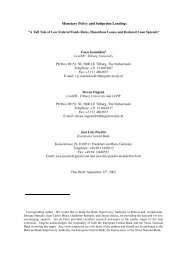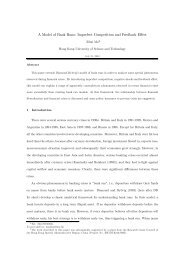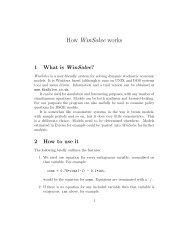Macroeconomics of the Franco-Prussian War Indemnity
Macroeconomics of the Franco-Prussian War Indemnity
Macroeconomics of the Franco-Prussian War Indemnity
Create successful ePaper yourself
Turn your PDF publications into a flip-book with our unique Google optimized e-Paper software.
Hong Kong Institute for Monetary Research<br />
this figure is that both observed GDP and consumption are quite well tracked by <strong>the</strong> model. This is <strong>of</strong><br />
particular interest because <strong>the</strong>se were <strong>the</strong> series not well explained by <strong>the</strong> transfer shock. In particular<br />
we found that GDP fell substantially in 1871 while <strong>the</strong> model with <strong>the</strong> transfer as <strong>the</strong> only source <strong>of</strong><br />
shock predicted a small increase in GDP. According to Figure 8, <strong>the</strong> resolution lies in <strong>the</strong> occurrence <strong>of</strong><br />
a large negative productivity shock in 1871. Likewise, <strong>the</strong> much bigger fall in consumption than predicted<br />
by <strong>the</strong> transfer alone can also be substantially explained by <strong>the</strong> size <strong>of</strong> <strong>the</strong> productivity shock in 1871.<br />
With respect to <strong>the</strong> movement in <strong>the</strong> terms <strong>of</strong> trade and trade balance, <strong>the</strong> model driven by productivity<br />
shocks alone fails to track <strong>the</strong> historical sample well. The key discrepancies are in <strong>the</strong> 1870-1873 period.<br />
But this is exactly <strong>the</strong> time <strong>of</strong> <strong>the</strong> transfer. We next put all three shocks toge<strong>the</strong>r to gauge <strong>the</strong> extent to<br />
which <strong>the</strong> model can reconcile <strong>the</strong>ory and <strong>the</strong> historical evidence.<br />
7.3 Complete Sample Paths<br />
Figure 9 illustrates <strong>the</strong> behaviour <strong>of</strong> <strong>the</strong> sample paths for <strong>the</strong> model when subjected to shocks to<br />
government spending, productivity, and <strong>the</strong> transfer, measured as described in <strong>the</strong> previous sections.<br />
The figure also illustrates <strong>the</strong> sample paths that are implied by <strong>the</strong> model in <strong>the</strong> absence <strong>of</strong> <strong>the</strong> transfer,<br />
but including both government spending and productivity shocks. Finally, we include <strong>the</strong> historical<br />
sample paths.<br />
The figure illustrates <strong>the</strong> extent to which <strong>the</strong> transfer <strong>of</strong> 1871-1873 can help to explain <strong>the</strong> behavior <strong>of</strong><br />
<strong>the</strong> French economy during this period. In <strong>the</strong> absence <strong>of</strong> <strong>the</strong> transfer, it is clear that <strong>the</strong> model does a<br />
very poor job <strong>of</strong> explaining <strong>the</strong> historical paths <strong>of</strong> <strong>the</strong> terms <strong>of</strong> trade and net exports for 1871-1873. But<br />
with <strong>the</strong> transfer, <strong>the</strong> size and timing <strong>of</strong> movement <strong>of</strong> both <strong>of</strong> <strong>the</strong>se variables are quite well explained. In<br />
particular, <strong>the</strong> net export series predicted by <strong>the</strong> model is remarkably close to that in <strong>the</strong> data. In <strong>the</strong><br />
model without productivity shocks, <strong>the</strong> transfer alone tends to make net exports rise too early, relative<br />
to <strong>the</strong> sample path, but <strong>the</strong> combination <strong>of</strong> <strong>the</strong> transfer with a large negative productivity shock causes<br />
<strong>the</strong> rise in net exports in <strong>the</strong> model to be delayed until 1871, exactly as in <strong>the</strong> sample path. In contrast,<br />
<strong>the</strong> terms <strong>of</strong> trade response in <strong>the</strong> model is somewhat delayed relative to <strong>the</strong> historical sample, again<br />
due to <strong>the</strong> negative productivity shock in 1871. However, <strong>the</strong> size <strong>of</strong> <strong>the</strong> terms <strong>of</strong> trade adjustment is<br />
exactly as in <strong>the</strong> sample.<br />
The reason for <strong>the</strong> delay in <strong>the</strong> terms <strong>of</strong> trade deterioration in 1871, in <strong>the</strong> model, is <strong>the</strong> big fall in export<br />
good production associated with <strong>the</strong> negative productivity shock in both sectors. The fall in exportgood<br />
output tends to reduce s, while <strong>the</strong> impact <strong>of</strong> <strong>the</strong> transfer tends to increase s. The end result is that<br />
s in <strong>the</strong> model hardly moves at all in 1871, while in <strong>the</strong> sample s rises sharply. In fact, <strong>the</strong> movement in<br />
<strong>the</strong> terms <strong>of</strong> trade is better explained in <strong>the</strong> model without productivity shocks. One possible explanation<br />
for this is that productivity shocks were concentrated in <strong>the</strong> non-traded goods sector. Figure 10 repeats<br />
<strong>the</strong> exercise <strong>of</strong> Figure 9, but assuming now that productivity shocks occur only in non-traded goods. In<br />
this case both <strong>the</strong> size and timing <strong>of</strong> <strong>the</strong> terms <strong>of</strong> trade response in <strong>the</strong> model are strikingly close to<br />
those <strong>of</strong> <strong>the</strong> sample path. At <strong>the</strong> same time, <strong>the</strong> movement in <strong>the</strong> net exports ratio remains close to <strong>the</strong><br />
sample. In fact, Figure 10 shows quite close accord between <strong>the</strong> model and <strong>the</strong> sample path for all<br />
variables.<br />
19








